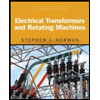The following reaction 2 NO(g) + O₂(g) → 2 NO₂(g) was found to be first order in each of the two reactants and second order overall. The rate law is therefore A) rate = K[NO]²[0₂] B) rate= K[NO] [0₂] rate k[NO₂]²[NO]² - [0₂] = D) rate= K[NO]²[0₂]² E) rate = k([NO] [0₂])-² T
The following reaction 2 NO(g) + O₂(g) → 2 NO₂(g) was found to be first order in each of the two reactants and second order overall. The rate law is therefore A) rate = K[NO]²[0₂] B) rate= K[NO] [0₂] rate k[NO₂]²[NO]² - [0₂] = D) rate= K[NO]²[0₂]² E) rate = k([NO] [0₂])-² T
Electrical Transformers and Rotating Machines
4th Edition
ISBN:9781305494817
Author:Stephen L. Herman
Publisher:Stephen L. Herman
Chapter3: Inductance In Alternating-current Circuits
Section: Chapter Questions
Problem 3RQ: To what is inductive reactance proportional?
Related questions
Question
![<
2:11
Question 4 of 15
The following reaction
2 NO(g) + O₂(g) → 2 NO₂(g)
A) rate = k[NO]²[0₂]
B) rate =
was found to be first order in each of the
two reactants and second order overall. The
rate law is therefore
= K[NO][0₂]
C) rate = K[NO₂]² - [NO]² - [0₂]
D) rate= = K[NO]²[0₂]²
E) rate = K([NO][0₂])-²
5GW
Tap here or pull up for additional resources
Submit](/v2/_next/image?url=https%3A%2F%2Fcontent.bartleby.com%2Fqna-images%2Fquestion%2F6c574046-7b70-423c-81c4-6874e86e9a66%2F20aacb2c-eb7d-495e-9467-7dc2618a2056%2Fycw10x8_processed.jpeg&w=3840&q=75)
Transcribed Image Text:<
2:11
Question 4 of 15
The following reaction
2 NO(g) + O₂(g) → 2 NO₂(g)
A) rate = k[NO]²[0₂]
B) rate =
was found to be first order in each of the
two reactants and second order overall. The
rate law is therefore
= K[NO][0₂]
C) rate = K[NO₂]² - [NO]² - [0₂]
D) rate= = K[NO]²[0₂]²
E) rate = K([NO][0₂])-²
5GW
Tap here or pull up for additional resources
Submit
Expert Solution
Step 1 of 2.
To choose:
The correct option.
Given:
The reaction is
Step by step
Solved in 2 steps

Knowledge Booster
Learn more about
Need a deep-dive on the concept behind this application? Look no further. Learn more about this topic, mechanical-engineering and related others by exploring similar questions and additional content below.Recommended textbooks for you

Electrical Transformers and Rotating Machines
Mechanical Engineering
ISBN:
9781305494817
Author:
Stephen L. Herman
Publisher:
Cengage Learning

Electrical Transformers and Rotating Machines
Mechanical Engineering
ISBN:
9781305494817
Author:
Stephen L. Herman
Publisher:
Cengage Learning